Kalash Valley Chitral, Pakistan | Kalash Valley Places to Visit Tourist Attractions | Location Map
The Kalash Valley is a fascinating area known for its cultural legacy and breathtaking natural scenery. It is located in Khyber Pakhtunkhwa, Pakistan’s Lower Chitral District. Bumburet, Rumbur, and Birir are the three main sections of the valley, home to the indigenous Kalash people. The biggest and easiest to reach, Bumburet, acts as a starting point for tourists who want to learn more about the rich traditions and customs of the Kalash people. The Kalash people provide an insight into a way of life that has largely been unaffected by contemporary influences. They are well-known for their distinctive polytheistic beliefs, colorful festivals, and traditional clothing. The valley’s verdant surroundings, terraced crops, and crystal-clear streams, encircled by the towering Hindu Kush mountains, provide a charming scene that appeals to both nature lovers and cultural travelers. By taking part in celebrations like Chilam Joshi, touring the Kalasha Dur Museum, or just interacting with the friendly inhabitants, visitors may fully immerse themselves in the culture. Kalash Valley offers a unique experience that highlights the rich fabric of Pakistan’s legacy, whether you’re looking for natural beauty or cultural enlightenment.

The Beauty of Kalash Valley
With its captivating combination of verdant landscapes, snow-capped mountains, and glistening rivers, Kalash Valley is a haven of natural and cultural splendor. The tranquil surroundings of the valley, which are encircled by the magnificent Hindu Kush range, offer a tranquil diversion from the bustle of the city. The lively culture of the Kalash people is what makes it unique; their traditional wooden homes, bright clothing, and centuries-old customs all combine to form a living, breathing work of art. Particularly during the spring and fall festivals, when the whole region is a riot of color, music, and happiness, every part of the valley is picturesque. It is undoubtedly one of Pakistan’s best-kept secrets.
Kalash Valley Tourist Places
Kalash Valley is filled with stunning tourist attractions that combine natural beauty and cultural richness. Some of the must-visit places include.



- Bumburet Valley: The largest and most accessible valley, Bumburet is known for its lush greenery, terraced fields, and traditional Kalash villages. It’s a great base for exploring the region.
- Rumbur Valley: Known for its peaceful and remote setting, Rumbur offers a more authentic Kalash experience, with fewer tourists and a chance to interact closely with the locals.
- Birir Valley: A picturesque valley that showcases the traditional Kalash way of life. Its unique architecture and serene surroundings make it perfect for cultural exploration.
- Kalasha Dur Museum: Located in Bumburet, this museum offers insights into the history, customs, and artifacts of the Kalash people, helping visitors understand the region’s heritage.
- Chilam Joshi Festival Grounds: If you’re lucky enough to visit during the Chilam Joshi festival, the grounds come alive with music, dancing, and colorful rituals. It’s one of the valley’s most celebrated cultural events.
- Krukal Village: A peaceful village with breathtaking views of the Hindu Kush mountains and the perfect place to connect with the Kalash tribe’s traditions.
These tourist spots provide a perfect blend of adventure, history, and culture in Kalash Valley.
Kalash Valley People
The Kalash people are an indigenous community residing in the Kalash Valley of Chitral, Pakistan. Known for their unique cultural traditions, religious practices, and distinct lifestyle, the Kalash are one of the most fascinating tribes in Pakistan. They have their own language, also called Kalash, which is an ancient Indo-Aryan language, and their religion is polytheistic, worshiping a variety of deities connected to nature.
The Kalash people are famous for their vibrant festivals, especially the Chilam Joshi, Uchau, and Chawmos festivals, which celebrate seasonal changes, harvests, and various other events in their agrarian calendar. They are also well-known for their colorful traditional attire, with women wearing black dresses adorned with intricate embroidery and bright accessories.
Their social structure is community-oriented, and they live in small, close-knit villages. The Kalash practice an animistic belief system, venerating natural elements like trees, rivers, and mountains. Despite external influences over the centuries, the Kalash have managed to maintain many of their age-old customs and traditions, making them a living example of an ancient way of life in modern times.
Visiting Kalash Valley offers an immersive experience into the lifestyle of these proud and resilient people, offering a glimpse into a culture that remains largely unchanged for centuries.
Kalash Valley Girls
Girls from the Kalash Valley play a crucial role in the distinctive cultural fabric of the Kalash people. Kalash girls are famous for their colorful and distinctive clothing, which consists of traditional costumes crafted from dark wool fabric embellished with beads, sequins, and colorful embroidery. Intricate headdresses fashioned from coins, beads, and shells are frequently worn with their attire and are seen as a sign of social standing and beauty.
In the Kalash Valley, girls are brought up with close cultural links and are taught the ancient crafts of basketry, weaving, and embroidery at a young age. Additionally, they learn about their people’s old traditions and rituals, such as their folklore, polytheistic religious practices, and the seasonal festivals that are an integral part of their life.
Kalash females are seen dancing and singing to commemorate the seasons and agricultural cycles throughout the region’s well-known festivals, such as Uchau and Chilam Joshi. These celebrations not only showcase their lively nature but also the part that women play in upholding and honoring Kalash customs.
Kalash girls continue to be stewards of their culture in spite of the difficulties presented by modernization, striking a balance between the traditional traditions of their community and external influences. They are the backbone of Kalash’s cultural continuity and play a crucial role in the community.



Kalasha Valley. This article offers a thorough description of the Kalash Valley, along with pictures of the local people and their surroundings.
Google Photos. A simple search for “Kalash Valley, Pakistan” will turn up a ton of images showing the valley’s stunning landscape, historic buildings, and colorful celebrations.
Travel blogs and photography websites.
Numerous tourists and photographers have shared their stories and stunning photos from their trips around Kalash Valley. User-generated images are frequently featured on websites such as Flickr and Unsplash.
You should be able to visualize the distinct charm of Kalash Valley with the help of these tools.
Feel free to inquire about any particular topics you’re interested in, such as the festivals, day-to-day activities, or landscapes, and I’ll be happy to point you in the direction of more focused material.
History of the Kalash Valley
With a rich and intriguing history dating back thousands of years, the Kalash Valley is situated in Khyber Pakhtunkhwa, Pakistan’s Chitral District. Over the ages, the Kalash people, who are said to be descended from the ancient Aryans, have managed to hold onto their distinctive
Language, culture, and religious customs.
There is a lot of mystery about the Kalash people’s history. According to some theories, they are descended from soldiers who traveled through the area in the fourth century BCE with
Alexander the Great’s army. Some people think that the Kalash have been in this region for a far longer time, maybe as part of the Hindu Kush region’s native population. Their distinct customs, polytheistic beliefs, and Indo-Aryan language set them apart from other ethnic groups in Pakistan.
Because of its steep topography, the Kalash Valley was historically cut off from the outside world, which allowed the Kalash people to maintain their long-standing customs. The Kalash have continued to follow their pre-Islamic religious customs to this day because of their remoteness, which also kept them mostly undisturbed by the introduction of Islam in the area.
The festivals of the Kalash people are closely linked to the agricultural calendar, and they revere a pantheon of gods and goddesses. With the valley’s natural beauty and seasonal celebrations like Chilam Joshi, Uchau, and Chawmos still playing a significant role in community life, their traditional customs have mostly not changed throughout time.
Despite the difficulties posed by outside forces and evolving times, the Kalash people’s ability to maintain their identity and customs is still a unique aspect of Pakistan’s cultural legacy. The valley is one of the most distinctive and historically rich areas in the nation because of its history, which combines old customs with contemporary tenacity.
Kalash Valley Visiting Points
- Bumburet Valley
- Rumor Valley
- Birir Valley
- Kalasha Dur Museum
- Chilam Joshi Festival Grounds
- Acholgah
- Krukal Village
Kalash Valley Waterfall
The Kalash Valley is well known for its breathtaking natural scenery, which includes several charming waterfalls tucked away in its verdant valleys. The Bumburet, Rumbur, and Birir valleys are known to have tumbling streams and waterfalls, particularly during the spring melt when snow from the nearby Hindu Kush mountains feeds into the rivers, even though the precise names of the region’s waterfalls may not be well known.
These waterfalls, which are frequently hidden in isolated locations, provide peaceful retreats for tourists looking for peace and scenic views. The trip to these falls usually entails picturesque excursions through thick forests and terraced fields, offering a close-up view of the beautiful surroundings of Kalash Valley. Hiring a local guide who is knowledgeable about the area and the best paths to these undiscovered gems is advised for anyone interested in seeing these natural wonders. Their expertise can improve your trip, guaranteeing your safety and a greater comprehension of the natural and cultural significance of the valley.
Kalash Valley View
With its verdant meadows, terraced farmland, and snow-capped peaks of the Hindu Kush mountain range, Kalash Valley provides stunning views. Traditional wooden homes and a thriving local culture complement the valley’s stunning scenery. When the valley is covered in golden leaves and blossoming flowers, the spring and fall seasons are the ideal times to enjoy these vistas. You can look through pictures of Kalash Valley on websites like Google Images or Unsplash to get a visual representation. A peek of the valley’s breathtaking landscape and cultural diversity can be found in these resources.



Kalash Valley Houses
The “wadas,” or traditional homes of the Kalash Valley, are a monument to the community’s unique architectural creativity and cultural legacy. The Kalash people’s sustainable lifestyle and the valley’s natural resources are reflected in these buildings, which are mostly constructed from locally sourced materials, including clay, stone, and wood. Architectural Elements:
Building Materials: Clay for insulation, timber beams, and stone walls and foundations are used to build the homes. By adjusting to the valley’s fluctuating climate, this combination guarantees longevity and thermal comfort.
Design Kalash homes usually have a central courtyard and a rectangular floor plan. The ground floor is utilized for living and social areas, while the higher floors are used for sleeping and storage.
Roofs are usually covered with thatch or wooden shingles, and the roofs are steeply pitched to avoid snow buildup in the winter.
Decorative Elements The community’s artistic expressions and spiritual beliefs are reflected in the numerous wooden carvings and elaborate designs.
Cultural Significance The Kalash people’s way of existence depends on these homes, which are more than just places to live. The layout and design promote social connections and community living, both of which are essential components of Kalash culture. The dwellings also contribute to the community’s spiritual activities; some of the buildings are used for ceremonies and rituals.



Kalash Valley Hotels & Guesthouses
Travelers looking for a genuine experience amid its breathtaking settings can find a variety of lodging options in Kalash Valley, ranging from comfortable guesthouses to boutique hotels. Kalash Valley’s Best Hotels & Guesthouses
Bumburet’s Kalasha Guest House
A well-liked option for tourists, with cozy accommodations and friendly service.
Guesthouses in the Rumbur Valley
Several family-run guesthouses offer a tranquil stay along with traditional Kalash cuisine and cultural activities.
Homestays in the Birir Valley
Staying with local families in their traditional homes will allow you to experience true Kalash culture.
Hotel Chitral Serena
This luxurious hotel in Chitral town provides contemporary conveniences and is a handy starting point for travel to Kalash Valley.
Inn Shandur (Chitral)
A reasonably priced choice that provides cozy lodging and convenient access to Kalash Valley.
It’s best to reserve lodging in advance when making travel plans, particularly during busy times like the May Chilam Joshi Festival. This guarantees a more pleasant stay as well as the chance to take in the distinctive hospitality and culture of Kalash Valley. Please inquire if you need help making reservations or additional details about any particular lodgings!
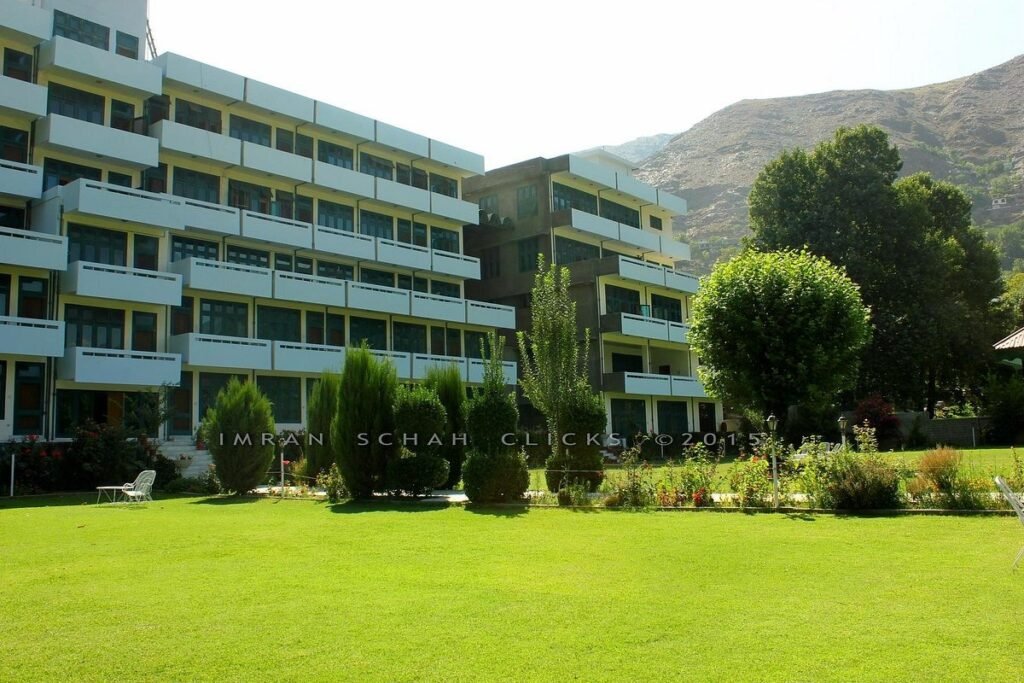


Kalash Valley location map

Kalash Valley Weather in Winter
The Kalash Valley undergoes a dramatic change during the winter months of November through March when temperatures drop sharply and snowfall falls heavily on the nearby mountains. An outline of what to anticipate from the winter climate is provided below
- The temperature
Temperatures during the day: Although the wind chill effect might make it feel colder, daytime temperatures can range from 0°C to 10°C (32°F to 50°F).
Nighttime Temperatures: The valley can experience cold temperatures at night, with lows of -5°C to -10°C (23°F to 14°F), particularly at the higher elevations.
More isolated locations, such as the higher-elevation Rumbur and Birir valleys, may experience more extreme temperatures.
- A snowstorm
During the winter, especially around December and January, Kalash Valley receives a lot of snowfall. It can be difficult to go to the valley because of the snow buildup on the nearby farms and roads.
Although the snowfall makes the valley a winter wonderland and adds to its natural beauty, it also raises the possibility of snow and landslides temporarily blocking access to the valley and its more isolated sections.
Kalash Valley weather in summer
The warm and pleasant summers of Pakistan’s Kalash Valley, which is in the Chitral District of Khyber Pakhtunkhwa, make it a popular destination for tourists looking for natural beauty and milder temperatures. Overview of the Summer
Climate (June–August)
- Highs on average: 23°C to 28°C (73°F to 82°F)
- Lowest temperatures on average: 12°C to 18°C (54°F to 64°F).
- Precipitation: Moderate, with sporadic flash floods because of the region’s steep terrain and issues with deforestation. ICT News
The cold and temperate temperature is influenced by the valleys’ height, which ranges from 1,900 to 2,200 meters (6,200 to 7,200 feet). A variety of crops, including wheat, maize, grapes, apples, apricots, and walnuts, are grown on the fertile ground in the area.



Best Time to Visit
The ideal time of year to visit Kalash Valley is thought to be during the summer. The weather is ideal for outdoor pursuits like trekking, camping, and cultural exploration at this time. The valley also holds colorful festivals that provide an insight into the Kalash people’s varied customs. Discover Mansoureh
Please ask any other questions you may have regarding the area or if you need help organizing your vacation!
Kalash Valley’s distance from Multan
Depending on the exact route followed, the distance between Multan and Kalash Valley in Khyber Pakhtunkhwa, Pakistan’s Chitral District, varies: Through the Kalash Valley Road: It takes roughly 13 hours and 3 minutes to drive 932 kilometers on the route. Calculator of Distance+1 Calculator for Distance +1
Via Chitral, it’s roughly 954 kilometers via road. Calculator of Distance+1 Calculator for Distance +1
Flight Distance Multan and Chitral are roughly 629 kilometers apart in the
Air.Wego
Please be aware that these are only estimates and may change depending on the route used and the precise beginning and finishing locations. Road conditions and other factors may also have an impact on travel times.
Kalash Valley distance from Islamabad
Depending on the method of transportation and the exact route followed, the distance between Islamabad and Kalash Valley, Pakistan, varies:
By Road Depending on the route used, the distance is between 366 and 401 kilometers.
Travel time is approximately five to six hours, though traffic and road conditions may cause this to change.
The recommended route is to take the M1 Motorway from Islamabad, get off at the Sher Khan Interchange, drive on the Swat Expressway, and then merge with the NH-45. Before arriving at Chitral and then the Kalash Valley, this road travels via Timergara, Lower & Upper Dir, and the Lowari Tunnel. Vance Rasaq +3Silk Road + 3 Visit Silk Road + 3
By air, Islamabad International Airport (ISB) and Chitral Airport (CJL) are connected by air.
Rome2Rio learn how to travel anywhere
Takeoff It lasts for around an hour and five minutes.
Rome2Rio learn how to travel anywhere+1Go to Silk Road +1
From Chitral to Kalash Valley It takes roughly two hours to drive (about forty-five kilometers) from Chitral to the Kalash Valley. There are some unpaved sections on the route, which can make conditions difficult.
kalash valley distance from other major cities
The following table illustrates the approximate travel time and distance between Pakistan’s major cities and Kalash Valley.
Distance from the City (By Road)
Notes on the Estimated Travel Time
The Islamic capital 366–401 kilometers
Five to six hours
Via the Lowari Tunnel and the Swat Expressway
642–690 kilometers from Lahore
Ten to twelve hours
Through the M2 Motorway to Islamabad and then to Kalash
932–954 kilometers from Multan
13 to 15 hours
Via Lahore or by M4 and N-45
Karachi
1,850–1,900+ kilometers
24 to 28 hours
The longest trip is advised by combining air and road.
The Peshawar
310–350 kilometers
6–7 hours
Through Lowari Pass and Dir
1,200–1,300 kilometers in 18–22 hours to Quetta
The city of Faisalabad
720–750 kilometers
11–13 hours
Via Islamabad to the Swat Expressway to Chitral Gilgit (no direct route): 520–600 kilometers
Not directly possible
There is no direct route; Islamabad must be traversed.
City of Chitral (30–45 kilometers)
One and a half to two hours
Note: Times and distances are estimates that are subject to change based on road conditions, traffic, and weather. Roads to Kalash might be difficult or seasonal, particularly after Chitral.
If you need route maps or flight alternatives for any city, please let me know!
Kalash Valley Famous Places
- Bumburet Valley
- Rumor Valley
- Birir Valley
- Kalasha Dur Museum
- Chilam Joshi Festival Grounds
- Acholgah
- Krukal Village
Kalash Valley Distance from Major Cities (Pakistan)
| City | Distance to Kalash Valley (Approx) | Estimated Travel Time (By Road) |
|---|---|---|
| Islamabad | 375 km | 10–12 hours |
| Lahore | 625 km | 14–16 hours |
| Peshawar | 280 km | 8–10 hours |
| Rawalpindi | 370 km | 10–12 hours |
| Karachi | 1,570 km | 25–28 hours |
| Multan | 850 km | 18–20 hours |
| Faisalabad | 700 km | 16–18 hours |
| Swat (Mingora) | 330 km | 9–10 hours |
| Abbottabad | 310 km | 9–10 hours |
| Chitral City | 35–40 km | 1.5–2 hours |
Kalash Valley festival date 2025
Every year, three significant festivals are held in Pakistan’s Kalash Valley, each of which honors the rich cultural legacy of the Kalasha people. The following dates for 2025 have been confirmed: Trungo Adventure #1 Tours with Apricot in Pakistan +1.
Dates of the 2025 Chilam Joshi Festival (Spring Festival): May 13–16
Location Celebrated in the Bumburet, Rumbur, and Birir valleys of the Kalash
Highlights Featuring traditional dances, music, and rituals, this celebration heralds the approach of spring. Additionally, it gives young Kalasha men and women a chance to meet possible mates. Songkick plus five Trango Adventure plus five Pakistani travelers plus five Hunza guides plus six Jasmine Tours plus six Jasmine Tours plus six
Apricot Tours in Pakistan
Dates of the 2025 Uchal Festival (Summer Festival): August 20–22
Location Rumbur Valley, mostly
Highlights The Kalasha people show their appreciation for the abundance of nature during the pre-harvest festival of Uchal. Processions, traditional dances, and group feasts of cheese, maize, and wine are all part of the festivities. Apricot Tours Pakistan +8
Hunza Adventure Tours +8 Trango Adventure
Winter Choimus Festival Dates: December 15–22, 2025
Place Seen all over the Kalash valleys
Highlights Choimus, which marks the end of the year, is the most important event for the Kalasha community. To ensure prosperity in the upcoming year, the celebrations include sacrifices to the gods, torch-lit processions, and cleansing rites.
Pakistan+7 Tours by Apricot
Pakistan Tours by Apricot Tours with Jasmine +7
If you’re interested in attending any of these festivals, it’s advisable to plan, as accommodations in the Kalash Valleys can be limited during these periods. Let me know if you need assistance with travel arrangements or more detailed information about the festivals.
Kalash Valley culture
The isolated valleys of Bumburet, Rumbur, and Birir in Chitral District, Khyber Pakhtunkhwa, Pakistan, are home to the Kalash Valley culture, one of the oldest and most distinctive living cultures on Earth. These valleys are home to the Kalasha people, whose unique customs, religion, language, and way of life have been kept for ages, making their culture both unique and intriguing.
Overview of Kalash Culture
An overview of Kalash culture and a description of its aspects
The Kalasha people are a minor Indo-Aryan community with an estimated 4,000–5,000 members.
Language Kalasha-mind, which is Dardic
Polytheistic religion is founded on nature worship and animism
Dress in colorful, handcrafted apparel; women don traditional headdresses and a lot of jewelry.
Location: Birir, Rumbur, and Bumburet Valleys
Beliefs and Religion
The polytheistic religion of the Kalasha is based on ritual purity, reverence for ancestors, and adoration of nature.
They have faith in several deities, including Mahandeo, Dezalik, and Balumain.
Festivals are important religious events that frequently feature dances, animal sacrifices, and offerings to the gods.
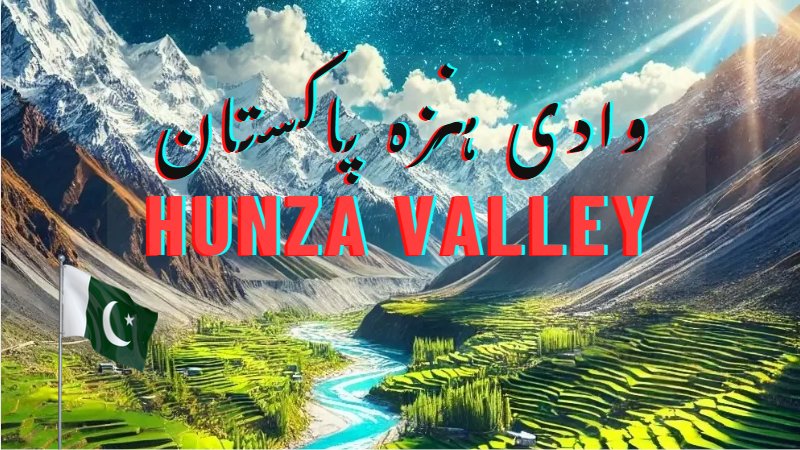
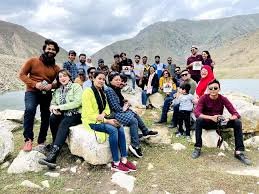
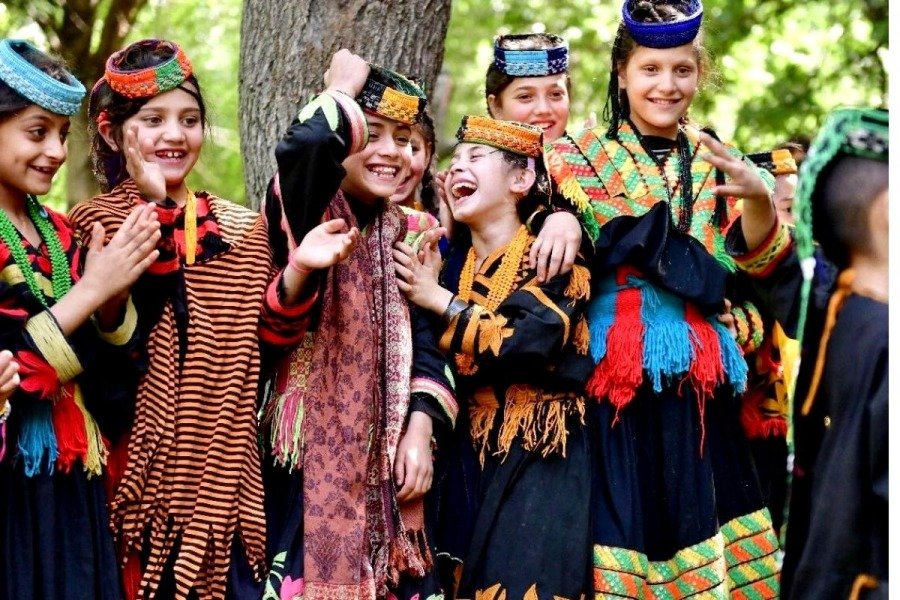
Traditional Dress
Women dress in long, black robes known as “Susutr” that are embroidered with various colors.
The “Kupas” headgear is embellished with coins, beads, and shells.
Men typically wear Chitrali caps and wear simpler woolen clothing.
Music, Dance, and Festivals
The essence of Kalash’s identity is dance and music. They frequently incorporate traditional group dances into their rituals and social events.
Folk songs and chants
Using goatskin dhols for drumming
Principal Festivals Festival Month Objective
Chilam Joshi May
Matchmaking and welcoming spring
August Uchal
Giving thanks to God for the crop, Choimus
December
The new year and the winter solstice
Food & Agriculture
The Kalash cultivate apples, apricots, walnuts, wheat, and maize, and produce their wine.
Dairy products like yogurt and goat cheese are part of their diet.
Ritual purity and food are intimately related; certain foods are kept apart for religious reasons.
Living & Architecture
Houses have flat roofs and are constructed of wood and stone.
The steep valley slopes are lined with houses.
Because of purity beliefs, women remain in a special dwelling called the “bashali” throughout their periods and deliveries.
Cultural Preservation Challenges
Threats to Kalash culture come from
Modernization
Conversion and pressure from religion
Mismanagement of tourism and climate change
Nonetheless, cultural tourism and educational initiatives are being used to help preserve their language and customs.
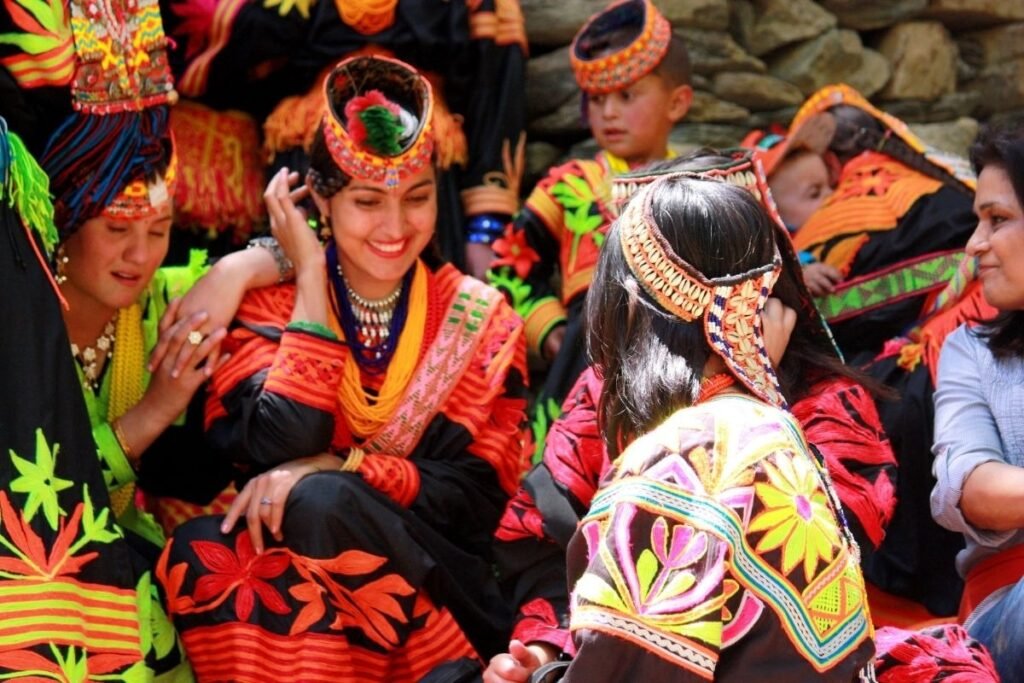


Day 01: we will pick you up from Multan and leave for Chitral 5 Days Tour Region. The road is full of picturesque sights. Via Swat Motorway to Lowari Tunnel, we shall reach Ayun Valley by evening & check-in at Ayunn Inn.
Day 02: The second-day w shall roam around the Ayun Village, visit the water channel, and walk along fruit-laden trees in Ayun. Here you will see the calmness and peacefulness of these people and areas with friendly manners.
Day 03: Leave after breakfast for the most interesting 4×4 adventure ride to reach Kalasha Valley. As you may know, Kalash tribes are present in three villages which are namely Bamburat, Rambore, and Barrier.
So, we are heading towards the biggest colony of Kalash people and shall visit the Museum, the old cemetery where you can experience GANDAU Statues with our experienced guides.
Day 04: The fourth day is full of exploration. We shall visit Chitral 5 Days Tour Town. Here you can reach in 45 minutes from Ayun Valley. Spending time in Chitral Mosque, the main Bazar, and also Chitral Museum, where history persevered. At night, we shall stay in Chitral town.
Day 05: This is the last day of the tour, we will drive to Multan from Lowari Tunnel after grasping some adventurous rides and the rich history of Kalash & Chitrali People. Chitral 5 Days Tour
Kalash Valley travel
One of Pakistan’s most distinctive and culturally diverse travel destinations is the Kalash Valley. This is your comprehensive guide to organizing a seamless and enjoyable vacation to this enchanted location:

